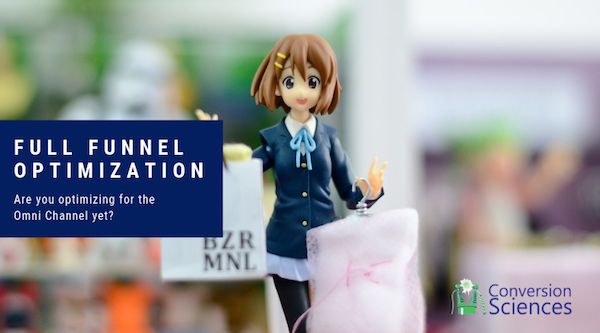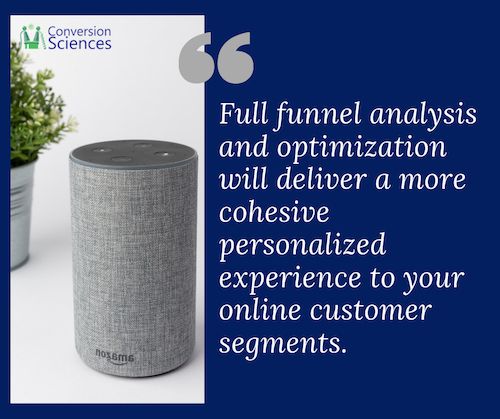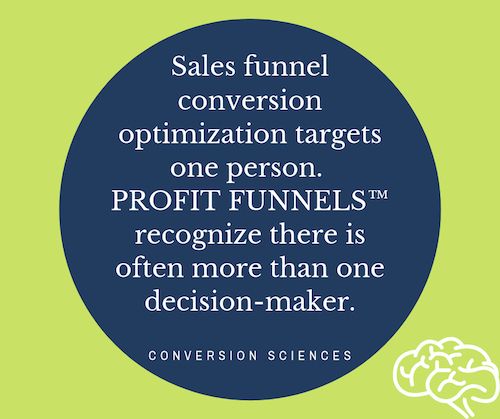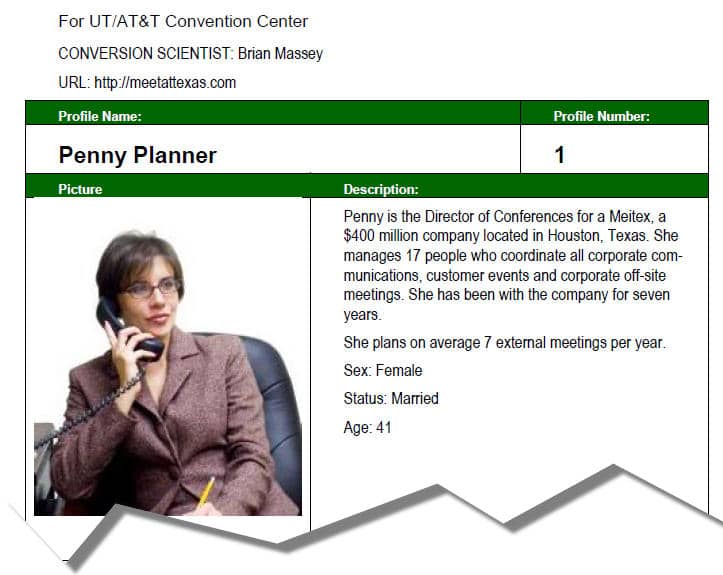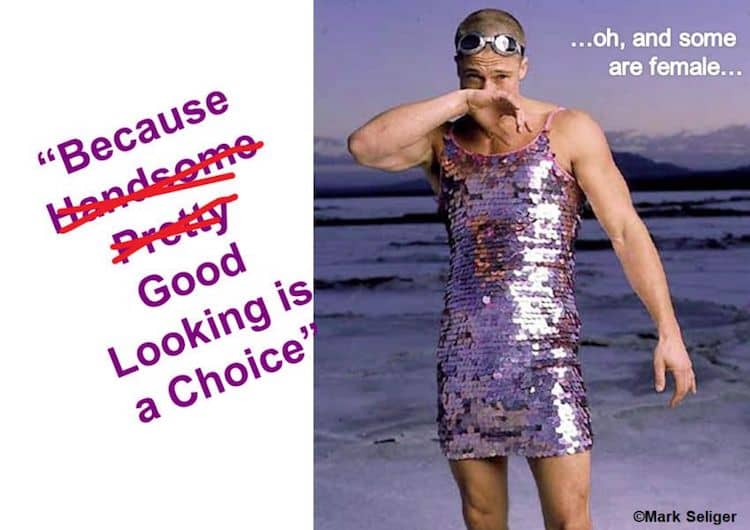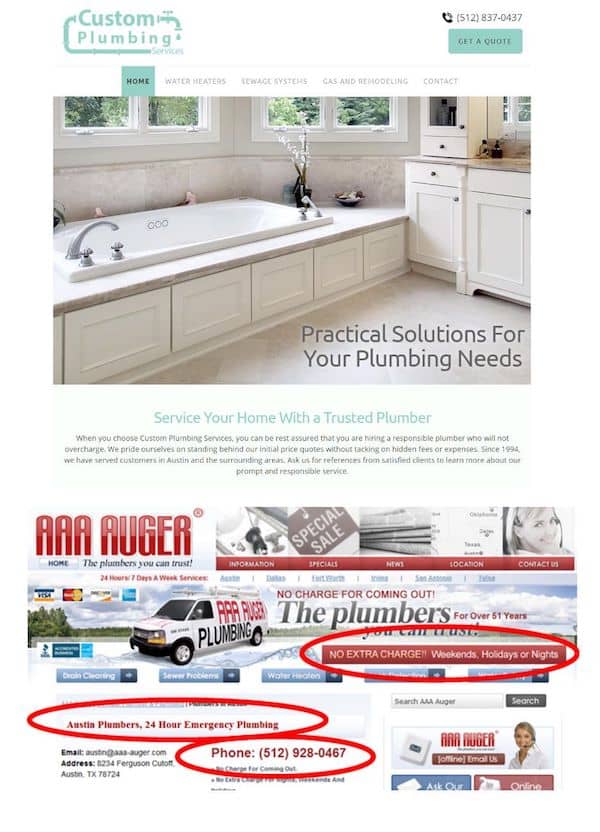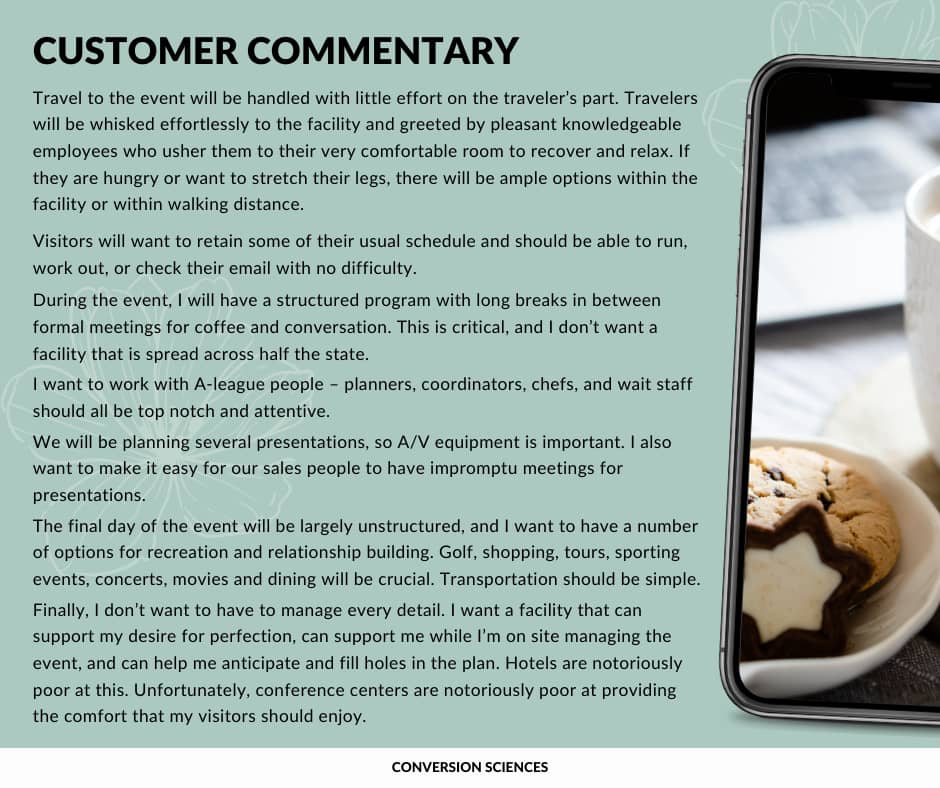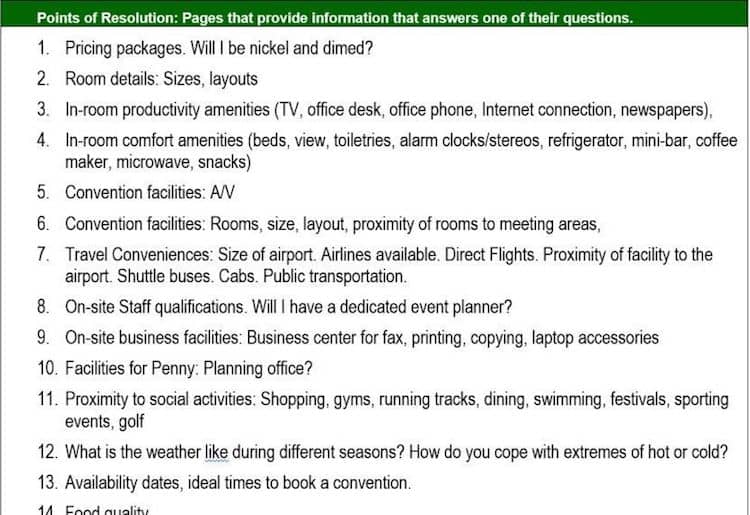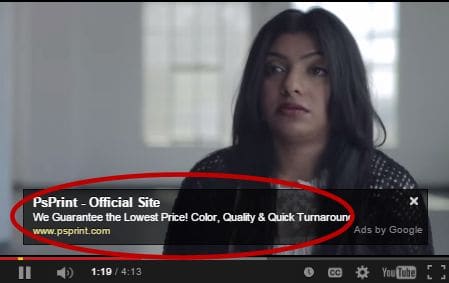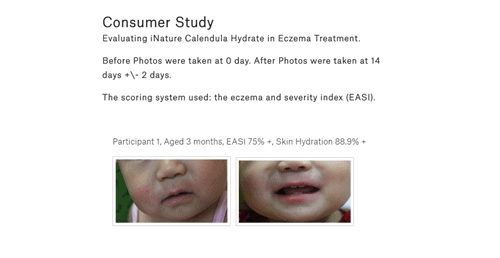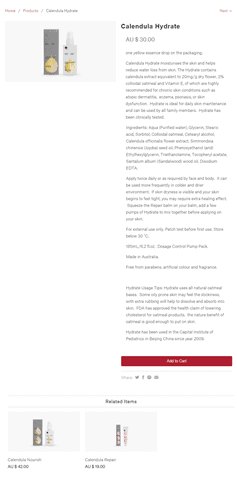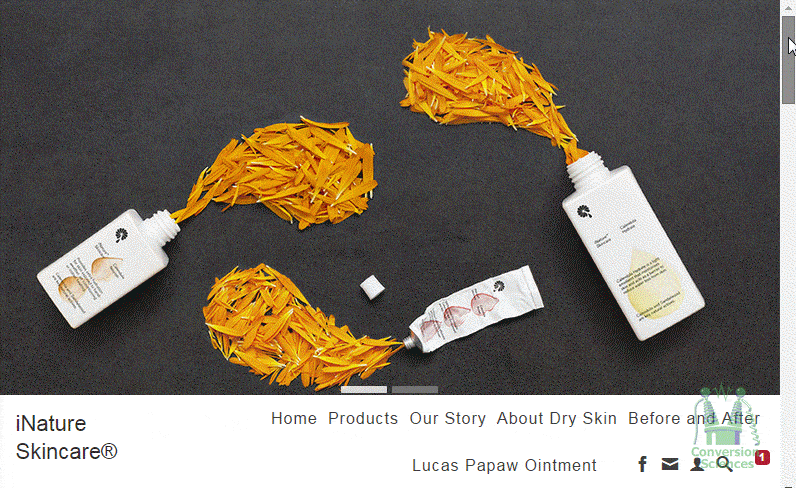An easy way to model your best visitors into 4 modes of research, the limits of demographics for buyer personas and how to overcome them, how to use analytics to uncover persona behavior. And we finish up with a fun conversion quiz to test your knowledge.
Demographics can lie to you. In fact, they often do. This makes them very unreliable when you are trying to make decisions about what to put on your website.
How demographics mislead us and how analytics can set us on the right page again.
The Content, headings, copy and images all impact the success of your site. Knowing how to develop these components for your particular audience is the key to higher and higher conversion rates.
I will guide you towards understanding your target audience showing you:
- An easy way to model your different buyers.
- How demographics often mislead us.
- How to find your ideal customers in your analytics.
- Then you get to test your own knowledge in the Conversion Quiz: What to Test?!
Accelerating Your Online Business by Optimizing for Buyer Personas
So you have a fantastic testing tool. You have this opportunity to test things on your pages, increase your conversion rates, move your business forward, hit the goals that you want.
The question is, what are you going to test?
Unless you have unlimited traffic, you can find yourself spending months trying to test through all the options.
I’m going to show you some basic principle that will help you better understand who you’re marketing to and help you choose the first thing to test.
You’re going to take a scientific approach and develop a list of hypotheses that are most likely to move things forward for your business or digital marketing strategies. Make those the first things that you’re going to test, and then we’re going to play the conversion quiz show.
An Easy Way to Model your Best Visitors: The limits of Demographics
First of all, the ground rules. Your business has only three or four customers living in thousands of addresses.
There are only three or four people coming to your website or your other online marketing from thousands of computers. And the point here is to try to sell to everyone.
And if you try to optimize a website for anyone that could be coming to the site, you are going to end up optimizing for no one. You’re really not going to learn very much. And the marketing you’re doing is not going to land.
Specificity is the hallmark of good conversion, high conversion rates.
So how do you get specific and target the right people that are coming to your site?
The answer is: you want to know who those best customers are, target the best customers.
What you’re doing is going to effectively target a much wider audience of those that are coming in. And it’s going to have this effect, those that are not as qualified pretty quickly are going to go away.
Let’s talk a little bit about demographics. We want to find and understand those three or four who are really the key visitors to our site that we really want coming.
Demographics is not sufficient.
Here’s a great example. Where does someone making $175,000 dollars a year live?
The marketing director might think $175,000, how can you even afford a house on that salary? The copywriter on the team might say, wow, with $175,000. I’d live in a mansion.
This is a simple illustration of why demographic segments don’t really give us the information that we need to know what to test.
Buyer Personas and Triggers
The key here is triggers. We don’t want to understand who people are. We want to understand why they’re on our site right now.
And if we can understand those core stories, we get some really powerful insights that are going to narrow down the content we’re making, how we’re talking to people.
Let me give you this example. Here is a woman, early 30s, and she needs a plumber because she wants to remodel her bathroom. So, she’s going to come to a plumbing website. She’s going to be interested in:
- Are they bonded?
- Are the crews qualified?
- Do they work with the materials used?
- Have they done anything with anybody else in my neighborhood?
- How long have they been in business?
- She’s going to really want to dig in because this is a big expenditure.
Same woman, same demographic has a leak and the water is about to ruin her new wood floors. She doesn’t care about whether you’re bonded at this point. She does not need any references. All she needs to know is:
- that you have trucks traveling the city
- that you can be there quickly
- and the phone number.
Same demographic, two very different sets of of conversion strategies that we would put in place on the plumbers’ website for those.
Four Modes of Research to Model Buyer Personas
Here’s a great model that the Eisenberg brothers put together in their book, Waiting for Your Cat to Bark. And it divides visitors into what we call their mode of research. They call it their mode of persuasion.
But this is how people are coming and how they want to get information on your website.
And there are two indices. They can be making decisions very quickly or very deliberately, very methodically, and they’re going to make decisions, emotionally or logically. And you’ll see how powerful this is.
We give this quarter some names.
The Competitives
The first quarter are those who make decisions quickly and logically, we call them competitives. These guys are goal oriented. They’re looking to solve a problem. They’re looking for something specific. They know what they’re looking for. And so they’re going to come to your website expecting you to help them drill down into what they’re looking for very quickly.
The Methodicals
The methodicals, on the other hand, make decisions deliberately and logically. They’re going to need more information. Methodicals don’t like the human touch. And in fact, they are probably not even going to call you. They already know, most of the answers to the questions that they might ask.
The humanists
The humanists make decisions very deliberately and very emotionally. These are some of the hardest folks to convert. They are looking for relationships in general. They want to know who they’re dealing with. They want to know the personalities of the company. And people in relationships are at the center of how they make decisions.
The Spontaneous
And then finally, the spontaneous visitors. They’re going to make a decision quickly. They’re going make a decision emotionally and they are looking for action. They’re activated by action. They’re not going to spend a lot of time doing research. This is the crowd that lends credence to the statistics you hear that you only have 8 seconds to get somebody’s attention on your website. That is not true, except for this kind of a visitor.
Understanding Buyer Personas Mode of Research
So let’s apply this to our early 30s woman, if she’s remodeling her bathroom, she’s probably going to come in a very methodical mode. She’s going to take time, research and take time to make a decision.
However, she’s going to be very spontaneous if you show her on the site, we have an emergency number. Here’s the number. She’s not going to think twice. She’s going to take action.
How to Use Analytics to Uncover Persona Behavior
Now, for those of you in the audience who might be a little competitive or methodical as you like to look at things logical, I’ve got a way of dicing this up, using analytics.
This is an illustration of how we can use what we learn from our analytics systems and from our tests to apply to this.
On my website, I can measure a couple of things. One of the things I can measure is how much time someone spends per visit. I can also measure how many pages they visit.
Time on site tells me if they’re spending a lot of time on site, then the approach is more deliberate.
If they spend less time then they are probably more quick decision making.
Visiting a lot of pages. I would think they’re proceeding in a more logical manner as opposed to fewer pages where they’re going to have more emotional triggers.
So I’ve given them these names.
- Bouncy Bob, the guy that didn’t spend any time on the site only visits a few pages and includes those people who are unqualified and bounce away.
- Lost Lucy, she’s spending not very much time on the site, but she’s visiting a lot of pages. And I call her Lost Lucy, because it’s like somebody trying to find what they’re looking for. This could be a frustrated competitive.
- Methodical Mary. Lots of time on the site. She’s going to look at a lot of pages.
- And One hit Juan, he’s going to spend a lot of time on site but he may only hit one or two pages. On my site there’s video pages where Juan is all over. He’s going to spend 40 minutes watching some video. That may be the only page that he looks at.
So when we put these into our analytics, we can get some interesting profiles. Of course, you may discover you have a high bounce rate due to more technical reasons and here’s how to fix your conversion problem.
Here’s a neat dataset that I have access to and 66% of the traffic is bouncy.
The first thing you might say is “I need to talk to my advertising guys because they’re not sending qualified traffic”. Conversion rate is very low 0.05%. About 7.6% of that traffic would qualify as a lost Lucy.
Again, a very low conversion rate. If these are those competitives that are coming, looking for something and we’re not doing a good job of selling it to them, we need to look at that. We need to get that conversion rate up. That’s a fair amount of traffic.
Juan in this data set was almost 6% of the traffic, a little bit better conversion rate 0.7%. So we’re doing something right.
But look at Mary, 23% of the traffic and she’s converting at over 3%. Here is an opportunity, 23 percent. What can I do to make sure that Mary is getting that information? She needs to make that deliberate and logical decision that she wants to make.
This is a great way that personas can play out in analytics.
How to Leverage Buyer Personas Mode of Research
So, let’s talk about how we use this. Let’s say we know what the stories are. We know we’ve got buyer personas coming in certain research modes and we may have someone in all of those research modes.
How does that affect our decisions? I’m going to show you some examples. Don’t go out and change your pages based on this, because the Conversion Scientist told you this is the way to lay it out.
These are some examples of things that you would test first if you knew who your personas were.
First of all, we’re all aware of the fold, the dreaded above the fold. We want that to appeal to our quick decision makers, our spontaneous and our competitors. We’ve got to get their attention above the fold because they’re not likely to scroll and stick around unless they see something relevant.
And below the fold, our consumers are methodical, who are a little bit more studied, paced and deliberate in their decision making, are more likely to scroll and see the information there.
What to Test with Competitives
So let’s look at our competitives. What would we put above the fold? Well, again, these guys know what they’re looking for, so we need what I call PAY-OFF copy.
We need a what’s in it for me headline and lots of what’s in it for me copy it them very quickly. Let them know why they need to stick around and take action.
These guys again, if your navigation is not satisfying them, give them a search box so that they can get to what they’re looking for.
They are looking for relevant pictures. They’re scanning for a reason to stick around and by relevant, I certainly don’t mean to stock photos that so many of our B2B sites have of pretty people. They want something that tells them they’re in the right place or at least on the right trail.
Spontaneous Buyer Persona Hypotheses to Consider
For our spontaneous type, quick facts, these guys are not going to spend a lot of time. If we can, above fold, give them the basic information they need to take action and give them an obvious way to take action, these guys will do that.
Bulleted benefits, details that they need to make a decision on the sale such as price. And a quick summary of what other people think of that are some ideas.
And then anything else that you want to support there, if you’ve got a guarantee, or anything to support the decision, it needs to be done in a very high contrast way. I facetiously call these the bright, shiny objects. But someone who is looking for ways to take action is going to be drawn to those.
Ideas to Test on Methodicals
Now, the methodicals, this one is a little bit of an exception. So above the fold, they’re going to be looking for a logical navigation.
And we all focus a lot on our basic tree navigation, our main navigation primary NAV. It appeals very much to these guys and to people who aren’t finding anything on the site.
But below the fold, you will want the details. These guys want to process that. They want to understand the details of how something works or what the details of the product are, depending on what you’re doing.
Also below the fold for humanists, we could put some social proof. So they’re looking for, again, a relationship and they put a lot of stock in what people think of a product. So the reviews and testimonials, those sorts of things would be valuable for them. And trust symbols, again, based on the relationships. If you have third party symbols, if you’re a member of associations, if you won awards, those will generally resonate with more humanist visitor.
These are the first things to test. As I said, don’t go off and just change things. This is where you want to start.
Fun Conversion Quiz to Test your Buyer Personas Knowledge
So that’s all very illustrative. Hopefully you’ve absorbed what I’ve said and you understand the concepts here. And we’re going to find out.
The way this is played is I’m going to describe a persona that is coming to a business and I’m going to provide 4 alternatives sources of things that we could test.
Your job is to tell me which ones you would test first. This one’s a gimme. So this is a practice.
The business is a plumber. This persona we’re calling Miriam the trigger is the sink is leaking profusely on new wood floors. Her mode of research: she’s coming to the site in a spontaneous mode.
What calls to action should we test first with this sort of a visitor?
- do we want her to contact us?
- do we want to provide her with a phone number?
- do we want a big red button that says emergency hotline with that number?
- big red button that gives her a vanity 800 number?
Actually, you might want to test both 3 and 4. She’s not going to be as interested in whether or not she’s paying a toll and an 800 number might sound like a national company.
So perhaps number three will be the one that we first test.
Let’s move on to another example.
The business sells sports equipment online. James is a soccer player, he plays to win and he spares no expense on game. His trigger, his teammate brought some hot new gear to the game and he is interested in keeping up. He’s coming in competitive research mode. He knows what he’s looking for.
What categories would we put in front of him? eCommerce sites typically divide things into categories functionally. So which ones would be the first ones we would test for him?
- Is it going to be soccer equipment?
- Is it going to be hot new products?
- Is it going to be editor’s choice
- Is it going to be best deals?
The twos and threes seem to have it, and I agree. So, hot new products is definitely what he’s looking for, an editor’s choice, something that the editors have found that is exceptional may also appeal to him. But I would say number two is awesome.
Why isn’t best deals the choice? Because he’s not looking to save money. He’s looking for what’s new and hot.
Let’s say we’re writing copy for a business software manufacturer, Roy is an operations manager. His boss asked him to research some workflow software. And now his job is kind of on the line. He’s spending somebody else’s money. So he’s going to come in a more methodical mode and take his time. This is a big decision.
What style of copy would appeal to Roy?
- Number one, something like “Our on-demand software provides the best of breed solution to quickly drive performance information to the right people in an organization.” Just sounds like a viable value proposition.
- Number two, “New IBM case study. Business Transformation achieved using SOA and other technologies for Texas Health and Human Services Commission.”
- Number three, a page that’s got a lot of detail, charts, graphs.
What do you think is going to appeal to our methodical Roy? I thought he would the IBM case study would appeal to him if it was relevant.
If it was a business like his or a specific problem like his or if he knew what SOA meant, number two might be a good one to test. But I think 3 would be the first thing that I would try.
This is a pet kennel business. Sarah, is a sales engineer, and she travels and she has these doggies that she loves and she needs a safe place for them when she goes on her business trips. And since these are her dogs and she’s very religious oriented, she’s going to come in a very humanist way.
So when she comes to our site, what headlines would we pick for her?
- The best price in town on kenneling services.
- Our trained staff looks forward to caring for your pet.
- The largest kennel in the city.
- Or give your dog a vacation.
What do we have here? Everybody seems to agree on to give your dog a vacation may also appeal to her. But I would say number 2 would be the first thing that I would test on this is our trained staff.
Again, relationships. You’re talking about your employees, not your business. That sort of language is going to appeal to a humanist.
All right, last one. The businesses: IT software. This is Rick, he’s an IT admin. Trigger: one of his servers is down and he needs a quick way to diagnose the problem. His mode of research: competitive. So you’re going to present him with a form, a demo form.
What text would you put on a button that would more likely ensure that he would finish the form and click the button?
He’s coming in a competitive mode. He knows what he’s looking for. He could also model as spontaneous. But since he’s an IT guy and he might be a little bit more logical about his decision making.
- Number one, Free demo. Submit.
- Number 2, Free demo. Start demo.
- Number three. Free demo. Next step.
- And number 4 Free demo. Download now.
Both 2 and 4 are good. To start the demo says I am about to get close to doing a download. Now I’m about to get closer to what I need to solve the problem. Submit, what is he submitting to? And next step sounds like, am I really getting there? Is there something else going on? He may bounce back and try a different site and download the demo there.
How Buyer Personas will Rock your Conversion Rates Summary
So this is one simple facet. I don’t know if you’re familiar with buyer personas, but they are a powerful tool. There are other facets because more commentary can give you great insights and the keywords, the list of what we call points of resolution, pieces of information they need to feel comfortable taking action is very important, where they’re coming from.
Are they coming from a search engine on certain keywords? Are they coming from an ad?
All of these play into a persona’s profile and each of them help you make better decisions about what to put on your site and what to be testing to get more people to convert to deals and move the business forward.
Ultimately, personas tell us and the entire team why they came. And if you’re dealing with managing a team, perhaps that is putting up the website, you’ve got designers, developers, it guys, copywriters, photographers, videographers, depending on the kind of content you’re putting out there, aren’t all of them going to have a different view of the customer?
You can give personas to each one of them and they will very quickly get an idea of who they’re designing for, who they’re creating for, etcetera.
It’s a very powerful tool for the team.
Webinar: Accelerating Your Online Business by Optimizing for Buyer Personas
Watch it now.
Password maxscientist
Thanks to Maxymiser for the opportunity to share this information with you.

